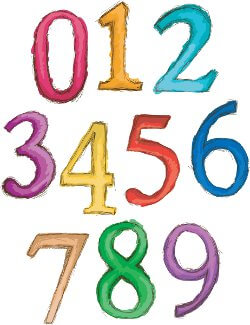Cardinal and Ordinal
Numbers
In speaking and writing, we use number for many purposes.
- to count people or things

- to put things in order
- to identify people or things
- as determiners
Click Here for Step-by-Step Rules, Stories and Exercises to Practice All English Tenses
In this lesson, we are going to focus on the common uses of cardinal and ordinal numbers. Cardinal and ordinal numbers are used for counting and putting things in order.
(When writing ordinal and cardinal numbers, you should use a hyphen for numbers from twenty-one to ninety-nine.)
| English Number | Cardinal | Ordinal | Ordinal Abbreviations |
| 1 | one | first | 1st |
| 2 | two | second | 2nd |
| 3 | three | third | 3rd |
| 4 | four | fourth | 4th |
| 5 | five | fifth | 5th |
| 6 | six | sixth | 6th |
| 7 | seven | seventh | 7th |
| 8 | eight | eighth | 8th |
| 9 | nine | ninth | 9th |
| 10 | ten | tenth | 10th |
| 11 | eleven | eleventh | 11th |
| 12 | twelve | twelfth | 12th |
| 13 | thirteen | thirteenth | 13th |
| 14 | fourteen | fourteenth | 14th |
| 15 | fifteen | fifteenth | 15th |
| 16 | sixteen | sixteenth | 16th |
| 17 | seventeen | seventeenth | 17th |
| 18 | eighteen | eighteenth | 18th |
| 19 | nineteen | nineteenth | 19th |
| 20 | twenty | twentieth | 20th |
| 22 | twenty-two | twenty-second | 22nd |
| 25 | twenty-five | twenty-fifth | 25th |
| 30 | thirty | thirtieth | 30th |
| 40 | forty | fortieth | 40th |
| 50 | fifty | fiftieth | 50th |
| 60 | sixty | sixtieth | 60th |
| 70 | seventy | seventieth | 70th |
| 80 | eighty | eightieth | 80th |
| 90 | ninety | ninetieth | 90th |
| 100 | one hundred | one hundredth | 100th |
| 125 | one hundred twenty-five | one hundred twenty-fifth | 125th |
Cardinal Numbers – Counting Numbers
Children are first introduced to cardinal numbers when they begin counting objects.
Cardinal numbers are numbers that tell you "how many." They express an amount.
We use cardinal numbers to count people or things. They indicate a quantity of people or objects.
Cardinal numbers are whole numbers. They do not contain fractions or decimals.

I bought two bananas at the store.

There are seven people in my family.
Ordinal Numbers – Position
Ordinal numbers are numbers that tell you the position of someone or
something in a group or list. Ordinal numbers tell order. Except for first (1st), second (2nd), and third (3rd), most ordinal numbers end in the letters "th."
- fourth (4th)
- fifth (5th)
- eighth (8th)
- thirteenth (13th)
- twentieth (20th)
- twenty-fifth (25th)
We can use ordinal numbers to tell the order people finish in a race or the order they are standing in line.

Nick finished the race in first place!
Nick's sister was tenth.

My daughter is third in line for
the bus.
Ordinal numbers are also used in recipes and instructions. They tell you the order of steps.
First, mix flour, sugar, and milk.
Second, add 1 teaspoon of cinnamon.
Second, add 1 teaspoon of cinnamon.
Cardinal and Ordinal Numbers
We can use cardinal and ordinal numbers together in the same sentence.Here's an example:
Tom's car finished 2nd in a race
of three cars.

In this sentence, we have used a cardinal and an ordinal number.
Cardinal numbers are used for counting. Cardinal numbers tell us "how many."
In the above example, three (3) is the cardinal number. It tells us how many cars were in the race. There were three cars in the race.
Ordinal numbers are used for putting thing in order. The ordinal number tells the position of Tom's car in the race.
In the above example, second (2nd) is the ordinal number. Tom placed second in the race. His car was the second car to cross the finish line. One car crossed the finish line before his car, and one car crossed the finish line after his car.
To learn more:
For additional information and rules for writing English Numbers, click here:English Numbers
These were examples and rules of Cardinal and Ordinal Numbers. Now that you know them, it is time to practice! Get our ESL Books.
Get Updates, Special Offers, and English Resources
Download your FREE GIFT (the first two chapters of
English Short Stories Book and Workbook)
as soon as you join!

By submitting your email, you consent to receiving updates and newsletters from us and to the sharing of your personal data with third parties for the purposes of sending you communications. We will not spam you. You can unsubscribe at any time. For more information, please see our privacy policy.
Return from Cardinal and Ordinal Numbers to English Numbers






